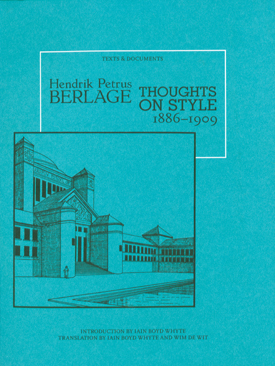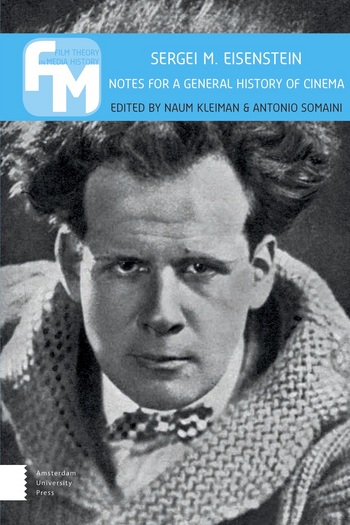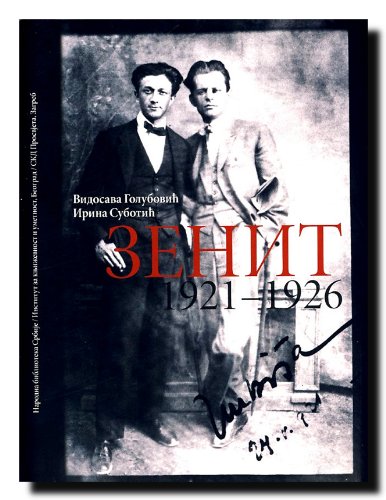Hendrik Petrus Berlage: Thoughts on Style, 1886–1909 (1996)
Filed under book | Tags: · aesthetics, architecture, art history, modernism, style, theory

“Looking back to the period around 1910, Mies van der Rohe once commented that there was but a single architect then working on the European architectural scene, “Berlage was a lone giant.”
In parallel activities as both an architect and an architectural philosopher, H. P. Berlage created a series of buildings that witnessed the gestation and birth of architectural Modernism and a body of writings that probed in depth the problems and possibilities of this new style. But whereas his Stock Exchange in Amsterdam, with its rational mastery of materials and space, has long been celebrated for its seminal influence on the architecture of the new century, Berlage’s passionate writings on architecture, which exerted an equal influence on his contemporaries, have often been neglected.
In his wide-ranging critical introduction, Iain Boyd Whyte convincingly demonstrates that one corpus of work cannot be understood without taking into account the other: Berlage’s writings inform his architecture to the same extent that his buildings reflect his probing aesthetic deliberations. Berlage’s principal texts are here brought together in English translation for the first time. Collectively, they present to the English-language reader a new and vital chapter in the history of European modernism.”
Introduction by Iain Boyd Whyte
Translated by Iain Boyd Whyte and Wim de Wit
Publisher Getty Center for the History of Art and the Humanities, Santa Monica/CA, 1996
Texts & Documents series
ISBN 0892363339, 9780892363339
331 pages
Review: Suzanne Frank (J Arch Education 1997).
Comment (0)Sergei M. Eisenstein: Notes for a General History of Cinema (2016)
Filed under book | Tags: · cinema, film, film history, film theory, media archeology, montage

“This comprehensive volume of Eisenstein’s writings is the first-ever English-language edition of his newly discovered notes for a general history of the cinema, a project he undertook in 1946-47 before his death in 1948. In his writings, Eisenstein presents the main coordinates of a history of the cinema without mentioning specific directors or films: what we find instead is a vast genealogy of all the media and of all the art forms that have preceded cinema’s birth and accompanied the first decades of its history, exploring the same expressive possibilities that cinema has explored and responding to the same, deeply rooted, “urges” cinema has responded to. Cinema appears here as the heir of a very long tradition that includes death masks, ritual processions, wax museums, diorama and panorama, and as a medium in constant transformation, that far from being locked in a stable form continues to redefine itself.
The texts by Eisenstein are accompanied by a series of critical essays written by some of the world’s most qualified Eisenstein scholars.”
Edited by Naum Kleiman and Antonio Somaini
Publisher Amsterdam University Press, Amsterdam, 2016
Creative Commons BY-NC-ND 3.0
ISBN 9789048517114
545 pages
Vidosava Golubović, Irina Subotić: Zenit, 1921-1926 (2008) [Serbian, English]
Filed under book | Tags: · art, art history, avant-garde, constructivism, dada, yugoslavia

A monograph about the Yugoslav magazine Zenit whose founder and editor Ljubomir Micić was the main progenitor of the avant-garde in Croatia and Serbia during the first half of the 1920s.
“Through the relentless publication of manifestos and statements in issue after issue of Zenit, Micić gave shape to a specifically Yugoslav avant-garde aesthetics: Zenitism, counterpointing the redemptive force of the Balkanic-Slavic ‘barbarogenius’ over against the decadence of Western Europe. Over the course of its five years of publication, Zenit accreted successive influences from international Expressionism, Futurism, Dada, and Constructivism to advance its cultural-political goals. Its political orientations were similarly idiosyncratic, eclectic, and fluctuating: a blend of Serbian nationalism, pan-Slavism, pacificism, Bolshevism (though often celebrating the anti-Western Russian character of Lenin and Trotsky rather than their Soviet politics), mystical new-age thought, internationalism, and anarchism. Zenit managed to garner a significant degree of international attention both for its solicitation of work for publication and for its subsidiary activities, such as the First Zenit International Exhibition of New Art held in Belgrade in April 1924. The example of Zenit and the aesthetic ideology of Zenitism inspired other important publications across the region, such as the Hungarian-language journal Út and the Slovenian journal Tank, as well as individual practitioners of avant-garde such as the Dadaist poet Dragan Aleksić and the Slovenian cubo-futurist Srečko Kosovel.” (Source)
The book includes two lead essays by Vidosava Golubović and Irina Subotić in English translation (pp 469-484).
Publisher Narodna biblioteka Srbije, Belgrade; Institut za književnost i umetnost, Belgrade; and SKD Prosvjeta, Zagreb, 2008
ISBN 867035182X, 9788670351820
516 pages
via Dubravka/MoW
Publisher (NBS)
Publisher (IKUM)
WorldCat

